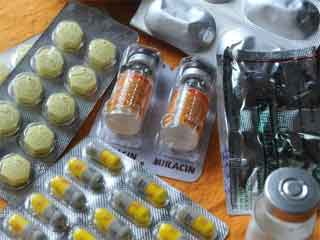भारत में सबसे ज्यादा इस्तेमाल होती है एंटीबॉयोटिक्स -
लंदन। भारत विश्व में एंटीबायोटिक दवाओं का सबसे ज्यादा खपत करता है। पिछले एक दशक में लोगों में एंटीबायोटिक खरीदने की प्रवृति में 62 प्रतिशत का इजाफा हुआ है। शोध के तहत वर्ष 2000 से 2010 के बीच 71 देशों में एंटीबायोटिक्स के इस्तेमाल का अध्ययन किया गया।
वर्ष 2000 में भारत में जहां एंटीबायोटिक की आठ अरब गोलियों का इस्तेमाल होता था वहीं वर्ष 2010 में इसकी संख्या बढ़कर 12.9 अरब हो गई है। "ग्लोबल ट्रेंड्स इन एंटीबायोटिक्स कंजम्पशन 2000-2010" शोध के मुताबिक, एक भारतीय एक वर्ष में औसतन 11 एंटीबायोटिक का सेवन करता है।
पिछले एक दशक में दुनियाभर में एंटीबायोटिक दवाओं का इस्तेमाल 36 प्रतिशत बढ़ा है। आर्थिक रूप से वृद्धि कर रहे देशों ब्राजील, रूस, भारत, चीन और दक्षिण अफ्रीका में एंटीबायोटिक दवाओं का एक तिहाई हिस्सा इस्तेमाल होता है। इन देशों के मध्य वर्ग की क्रय शक्ति में इजाफा हुआ है।
जर्नल लेसेंट में प्रकाशित रिपोर्ट के मुताबिक, एंटीबायोटिक्स के अधिक इस्तेमाल से लोगों पर दवाइयों का असर कम होने और दवा प्रतिरोधी बैक्टीरिया के प्रभावी होने की आशंका बढ़ी है।
प्रमुख शोधकर्ता थॉमस वान बोकेल ने कहा, लोगों की क्रय शक्ति बढ़ रही है और वे आसानी से एंटीबायोटिक्स खरीद सकते हैं। अगर इन दवाओं का प्रभाव समाप्त हो गया तो वास्तव में कुछ नहीं बचेगा।
उन्होंने कहा, निम्न और मध्य आय वाले देशों में सेफैलोस्पोरिन और फ्लोरोक्विनोलोन के उपयोग में वृद्धि से साफ पता चलता है कि इन देशों में डेंगू, चिकुनगुनिया जैसी बीमारियों तेजी से फैल रही हैं।
इनमें से ज्यादातर बीमारियां वायरस से फैलती हैं जिनपर एंटीबायोटिक्स प्रतिक्रिया करते हैं। लेकिन ज्यादातर देशों में इंफ्लुएंजा के फैलने पर भी एंटीबायोटिक्स का इस्तेमाल किया जा रहा है जबकि फ्लू पर ये दवाइयां असर नहीं दिखाती।

LONDON: India has emerged as the world's largest consumer of antibiotics, with a 62% increase in use over the past decade.
'Global Trends in Antibiotic Consumption, 2000-2010', a study by scientists from Princeton University, has found that worldwide antibiotic use has risen by 36% over those 10 years, with five countries — Brazil, Russia, India, China and South Africa (BRICS) — responsible for more than three-quarters of that surge. Among the 16 groups of antibiotics studied, cephalosporins, broad-spectrum penicillins and fluoroquinolones accounted for more than half of that increase, with consumption rising 55% from 2000 to 2010.
During this period, India's antibiotic use went up from eight billion units (2001) to 12.9 billion units (2010).
The study quantifies the growing alarm surrounding antibiotic-resistant pathogens and a loss of efficacy among antibiotics used to combat the most common illnesses. It confirms an increasing resistance to carbapenems and polymixins, two classes of drugs long considered the last resort antibiotics for illnesses without any other known treatment.
"Indians consume around 11 antibiotic tablets per year," Ramanan Laxminarayan, one of the authors of the study, told TOI. "That's five days of antibiotics for every person in the country, which is more than the Chinese or Brazilians. An average Chinese popped seven antibiotic pills a year. However, both India and China's numbers are lesser than the Americans who on average pop 22 antibiotic pills a year. The paper confirms that global use of antibiotics is surging and specially in India."
Laxminarayan said that was both good news and bad news. "It means that more Indians are able to access antibiotics, which are particularly important for those who previously died of easily treatable infections," he said. "However, the massive increase in use, both appropriate and inappropriate, is leading to increases in drug resistance. Antibiotic use is the single most important reason for resistance. Also use of last resort drugs like carbapenems has gone up significantly in India, and it is difficult to justify why such powerful antibiotics are being use so much more frequently."
Laxminarayan said it had to be remembered that before we had antibiotics, it was pretty easy to die of a bacterial infection. "And we're choosing to go back into a world where you won't necessarily get better from a bacterial infection," he said. "It's not happening at a mass scale, but we're starting to see the beginning of when the antibiotics are not working as well."
Professor Dame Sally Davies, chief medical officer for England and chief scientific adviser for the Department of Health, London, said: "This paper breaks new ground with the comparative antibiotic consumption data by country of the first decade of the 21st century. There is a direct relationship between consumption and development of antibiotic resistance, so the data is key for us all developing a 'National Action Plans Against Antimicrobial Resistance' as set out in the World Health Assembly Resolution in May."
The study noted that the use of antibiotics tended to peak at different times of the year, corresponding in almost every case with the onset of the flu season. In the northern hemisphere, for example, consumption peaked between January and March, while in the southern hemisphere it peaked between July and November. One notable exception was India, for which usage peaked between July and September, correlating with the end of the monsoon season.
कोई टिप्पणी नहीं:
एक टिप्पणी भेजें